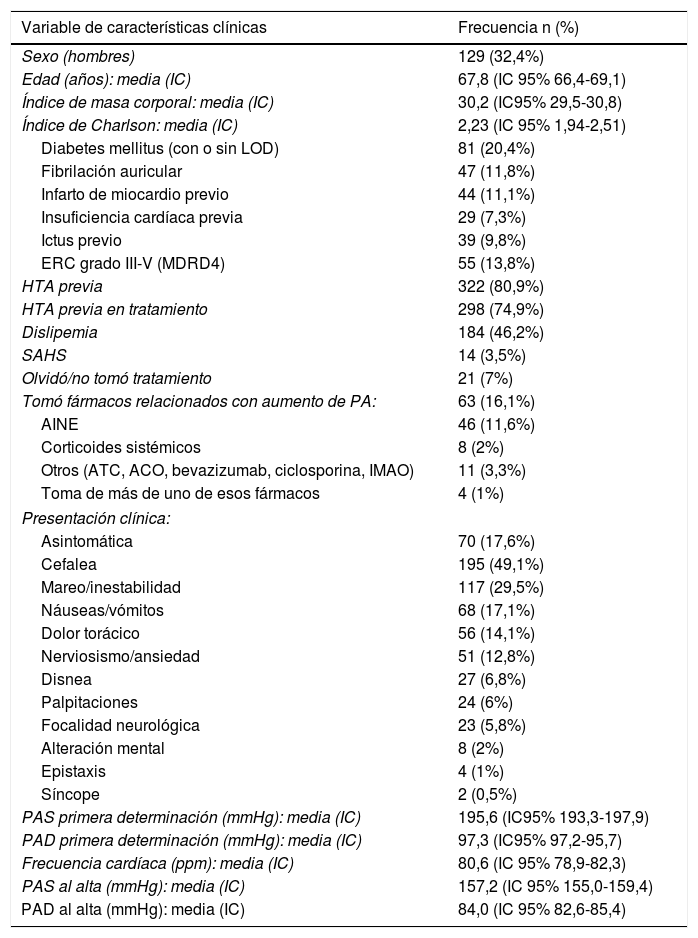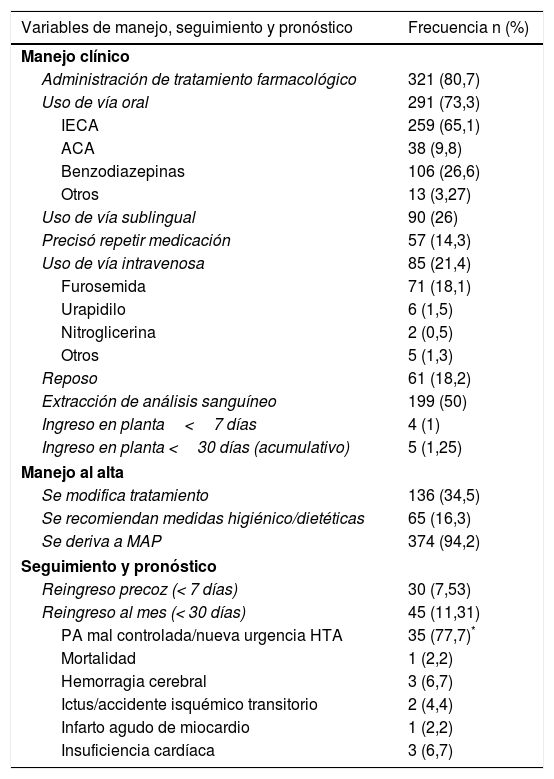Describir las características de las urgencias hipertensivas atendidas en un Servicio de Urgencias, así como las variables asociadas a reconsulta precoz (< 7 días) y al mes (< 30 días).
MétodosSe realizó un estudio descriptivo, retrospectivo de todos los pacientes atendidos en el Servicio de Urgencias de un hospital de tercer nivel durante el año 2013. Posteriormente se realizó un análisis de casos-control para analizar el grupo de pacientes con reconsulta.
ResultadosSe analizaron un total de 398 urgencias hipertensivas (32,4% hombres, edad media 67,8 años) lo que representó una incidencia de 3,28/1.000 visitas. Un 80,9% eran hipertensos previamente, siendo 2,23 la media de Índice de Charlson. La cefalea fue el síntoma más frecuente (49,1%), seguida del mareo/inestabilidad (29,5%) y las náuseas/vómitos (17,1%). Un 80,7% de los pacientes recibieron tratamiento farmacológico. Las tasas de eventos cardiovasculares o mortalidad al mes fueron bajas (2,26% y 0,25% respectivamente). Pese a ello, un 7,53% y un 11,31% de los pacientes reingresaron antes de 7 días o 30 días, respectivamente. Las variables asociadas a reconsulta en el análisis multivariante fueron la presión arterial sistólica elevada en la primera determinación, la hipertensión arterial previa y la presencia de palpitaciones.
ConclusionesLas urgencias hipertensivas son entidades de elevada incidencia en los Servicios de Urgencias. En nuestro estudio, los individuos con diagnóstico previo de hipertensión arterial y la presión arterial sistólica elevada en la primera determinación tienen mayor riesgo de reconsulta y serían candidatos a un seguimiento más estrecho al alta.
To describe the characteristics of hypertensive urgencies at the emergency department, as well as the variables associated with early re-admission (<7 days) and re-admission at one month (<30 days).
MethodsWe conducted a descriptive, retrospective study of all patients who were admitted to the emergency department of a third level hospital during 2013. Subsequently, a case-control analysis was performed to analyze the group of patients with readmission.
ResultsA total of 398 hypertensive urgencies were collected (32.4% men, mean age 67.75 years), which led to an incidence of 3.28/1000 visits. Eighty point nine percent had a previous history of hypertension, and the mean Charlson Index was 2.23. Headache was the most frequent symptom (49.1%), followed by dizziness/instability (29.5%) and nausea/vomiting (17.1%). Eighty point seven percent of the patients were prescribed pharmacological treatment. The rates of cardiovascular events or mortality at one month were low (2.26% and 0.25% respectively). Despite this, 7.53% and 11.31% of patients were readmitted in under 7 days or 30 days, respectively. The variables associated with readmission in the multivariate analysis were elevated systolic blood pressure in the first determination, previous hypertension and the presence of palpitations.
ConclusionsHypertensive emergencies are high-incidence conditions in the Emergency Department. In our study, patients with a prior diagnosis of hypertension and elevated systolic blood pressure at the first determination had a higher risk of re-entry and would be candidates for closer follow-up on discharge.









